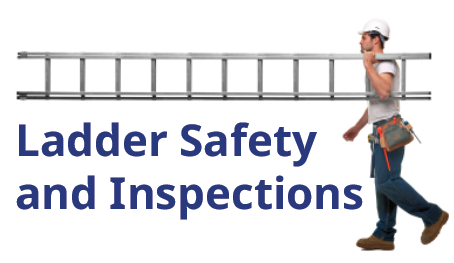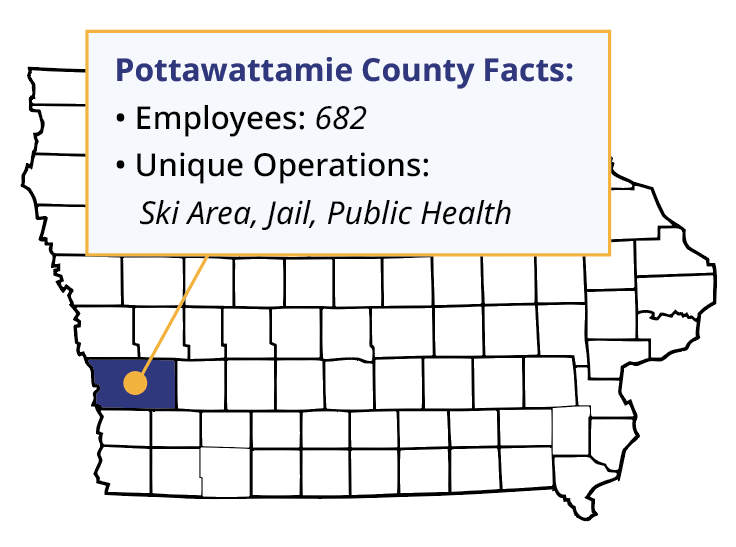
March is Ladder Safety Month. Ladders remain a leading factor in workplace injuries and fatalities. Let’s examine how you can protect yourself and your coworkers when using ladders. These apply to step ladders, portable ladders and ladders that are fixed in place.
The first thing to do before using a step or portable ladder is to check its rating and load capacity. Only ladders that are rated for commercial or industrial use (Type I or II) can be used in workplaces. Do not use any ladder that is rated for residential or household use (Type III) when at work since these are for light duty. Also, make sure that the load capacity can handle the combined weight of yourself and any items you need to have with you on the ladder. If the rating and/or load capacity labels are not legible, the ladder must be removed from service until the labels are replaced.
For a fixed ladder, you want to make sure it is securely attached, and if equipped with a cage, that the cage is also secured properly. If either is loose, do not use the ladder and report the condition to management immediately.
Ladders should always be inspected before use. If any of the following is found, do not use, remove from service, and report to management: Broken, bent or missing rungs or steps; broken or split side rails; missing or damaged cleats/feet; corrosion damage; and/or damaged extension locks.
When using any type of step or portable ladder, make sure to use it properly. Always use step ladders in their fully opened position, never as a make-do portable ladder leaning against something. When using a portable ladder, ensure that it is tall enough to allow you to conduct your work without having to use the top step or rung. You also want to make sure that the ladders are positioned on a stable surface and that the ladder is in a vertical, not leaning left or right, position.
Always use three points of contact when using the ladder and keep your body near the middle of the rungs or steps. Do NOT “reach or stretch” in a manner that takes the middle of your chest past one of the rails of the ladder. And always face the steps or rungs when climbing up or down the ladder.
There are many other issues to consider to using ladders safely. For further guidance, OSHA offers a “Quick Card” for Portable Ladder Safety (click here.) OSHA also offers a full guide, “Stairways and Ladders” that provides a wealth of information for all types of ladders (click here.)
Register Now for
IMWCA University
Check out this short video to learn more about what to expect.
Eye Safety – Protect Your Peepers

March is Eye Safety Protection Month. This is a good time to make sure you and your colleagues are aware of the hazards present in your work environment that could cause damage to your eyes. Knowing the hazards can help you identify strategies to reduce the possibility of injury.
Ensure that when selecting safety glasses, you look for the ANSI Z87.1 or Z87.1+ certification. This certification means the safety glasses have been tested to meet specific impact protection standards. The “+” certification means the glasses meet a higher impact standard.
Flying debris and objects. Grinding/buffing grit and the material being ground or polished present a significant risk. While wearing safety glasses is a minimum, many employers now require the use of face shields, which provide full face protection, when undertaking these tasks.
Working Outdoors. Direct sunlight, dust and/or materials moved by wind or landscaping equipment can be a hazard when working outdoors. Wearing Safety glasses with side protection (side shields or wrap around style) and that also provide UV protection are effective personal protective equipment.
Falling materials. Make sure to use safety glasses when working in situations that present the possibility of falling materials such as dirt or other debris. In these situations, use of safety glasses designed for mechanics are very effective as they provide additional protection beyond standard safety glasses.
Ultra Violet (UV) Protection. The use of UV disinfection processes in the water and wastewater sectors is becoming more common and poses a serious hazard to workers if they are exposed to UV radiation. Most treatment systems are designed to shut off the UV systems when workers are present. However, when working in proximity to UV systems, workers should always wear safety glasses that also provide UV protection.
Liquids, chemicals, lubricants, fuels and contaminated water. Working around these liquids often requires many different types of PPE. Make sure that safety glasses or face shields are utilized as well.
Member Highlight: Pottawattamie County

Garfield Coleman, Risk Manager and Jacob Head, Safety Coordinator with Pottawattamie County provided some insight on what the County has been doing to develop and maintain their safety culture.
What is your city doing to provide a safe workplace?
Board of Supervisor’s Statement of Safety: The success of Pottawattamie County depends upon our efficient use of resources to produce a high quality product for the citizens of our community. Our most important resource is our employees. To protect this resource, we are committed to providing a safe and healthful workplace for all employees by establishing and maintaining an effective safety and health program. We consider safety to be a core value of our organization’s operations. The occupational safety program of Pottawattamie County is organized to give each department responsibility for the accident prevention program. Employees at all levels of our workforce are directed to make safety a matter of continuing concern, equal in importance to all other operational considerations. We are all expected to cooperate in implementing safety practices and to adopt the concept that the safe way to perform a task is the most efficient, and the only acceptable way to perform it.
- We conduct Job Hazard Analysis with all Department Leadership.
- We develop, implement and manage effective loss prevention policies to assure a safe, healthful and productive workplace, and to ensure compliance with applicable state and federal regulations.
- We provide training to employees and management such that an understanding of hazards and respective safety requirements are established and supported.
Do you have a Designated Provider and a Return-To-Work policy?
Yes, and Yes
Policy: Employees are Pottawattamie County’s most valued assets. Employee safety and wellbeing are a major concern for the County. When employees become ill or are injured on the job, it is our intent to assist them with a quick recovery and return them to meaningful employment.
It is the policy of Pottawattamie County to provide modified or alternate work for employees injured on the job, if the employee is temporarily unable to perform the duties outlined in his/her job description. Restricted/Modified duty will be provided as available in compliance with the Americans with Disabilities Act (ADA) and the Iowa Worker’s Compensation Act.
Pottawattamie County will make reasonable accommodations to a disability unless the accommodations would impose an undue hardship on the employer. The disabled employee must be able to perform the essential functions of the job with or without reasonable accommodation.
The feasibility of reasonable accommodations shall be determined on a case-by case basis taking into consideration the employee, the specific physical or mental impairment, the essential functions of the job, the work environment, and the ability to provide accommodations.
Please describe your safety committee structure. Who is on the committee, how often do you meet and what are the short-term goals of the committee?
Each department has a safety committee and/or a Designated Department Representative that is responsible for conducting discussions at departmental meetings to discuss safety committee meeting items and issues. Conducting quarterly walk-through safety audits for each department and prepare findings report. Meeting with the Elected Official/Department Head and Risk Manager to review the audit and findings report. Ensuring that the findings report is posted in a designated area. Reporting ANY unsafe acts or conditions to the department supervisor IMMEDIATELY. Assisting, as needed, in conducting workplace injury or “near miss” incident investigations. Continually reviewing the effectiveness of safety programs and make recommendations for improvements.
Committees are comprised of individuals from every level of a Departments organization chart. To name a few, Employees, Frontline Managers, Captains, Lieutenants, Union representatives and more.
Our Goals:
- Develop an accident-free work environment, which is safe, clean and productive for our employees and contractors.
- Minimize our worker’s compensation insurance cost.
- Provide training to employees and management such that an understanding of hazards and respective safety requirements are established and supported.
- Develop, implement and manage effective loss prevention programs to assure a safe, healthful and productive workplace, and to ensure compliance with applicable state and federal regulations.
- Encourage the responsibility and participation of all employees and management in Pottawattamie County’s loss prevention efforts.
What other proactive safety steps do you practice?
- We clearly outline the responsibilities of Supervisors and Employees in all of our safety and health policies.
- We have a fantastic working relationship with our Issuance Broker.
- Lead by example.
- Address emergencies.
What words of wisdom do you have for other members of IMWCA to help them develop their safety culture.
Establish best work practices for employees follow. Here are some simple steps you can take to get started. Completing these steps will give you a solid base from which to take on some of the more structured actions presented in the recommended practices.
- Set safety and health as a top priority
- Lead by example
- Implement a reporting system
- Provide training
- Conduct inspections
- Collect hazard control ideas
- Implement hazard controls
- Address emergencies
- Seek input on workplace changes
- Make improvements
What current issues is the committee working on now?
- We are currently working on UTV Driver Coach Program
- Safety leadership skills
- Employee engagement/Incident reporting
- Culture change
Thank You For Your Service

IMWCA would like to congratulate Teresa Rotschafer, former Assistant City Administrator/Finance with the city of Johnston on her recent retirement. Teresa started on the IMWCA board in November of 2021 and her dedicated service will be missed.





